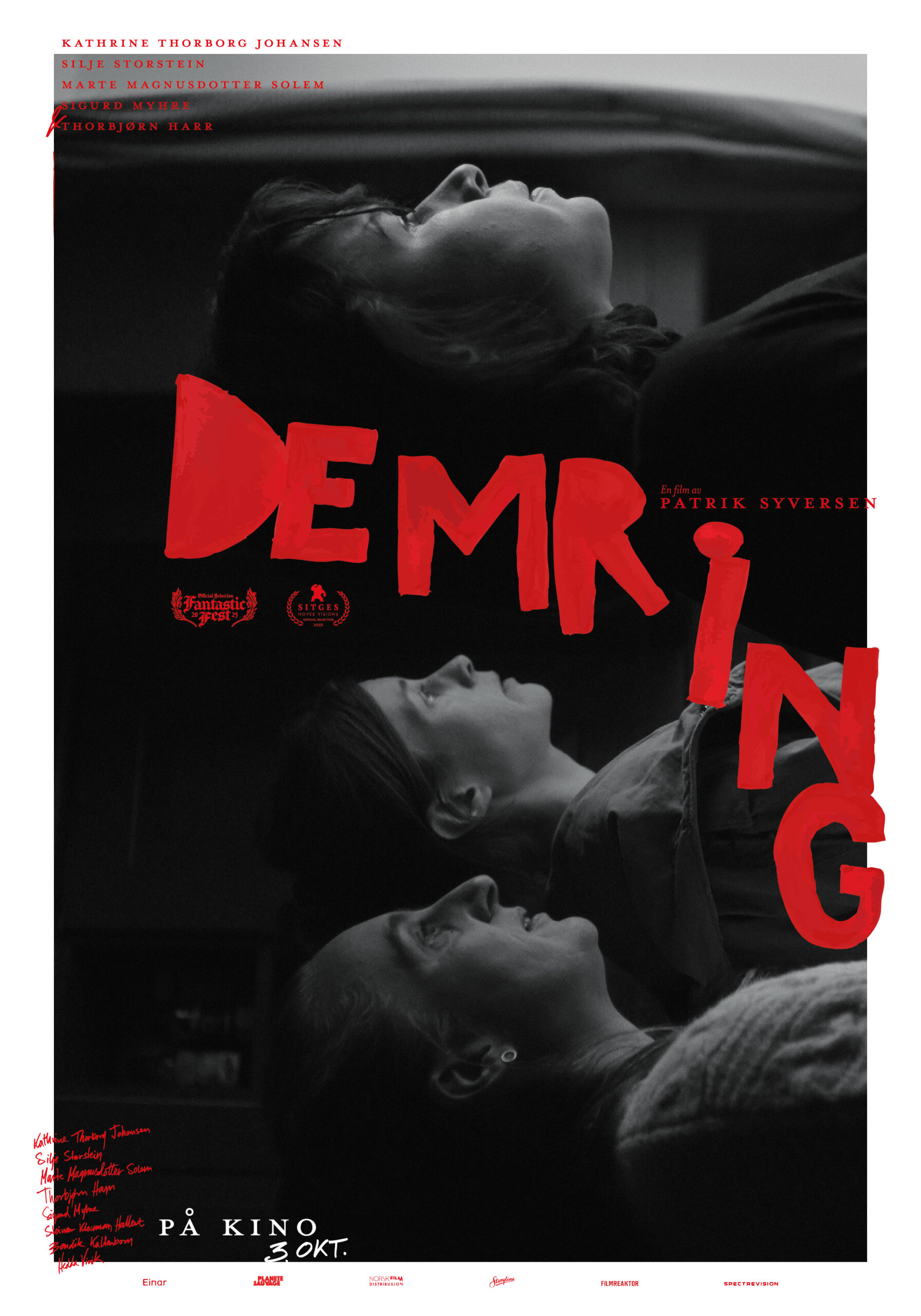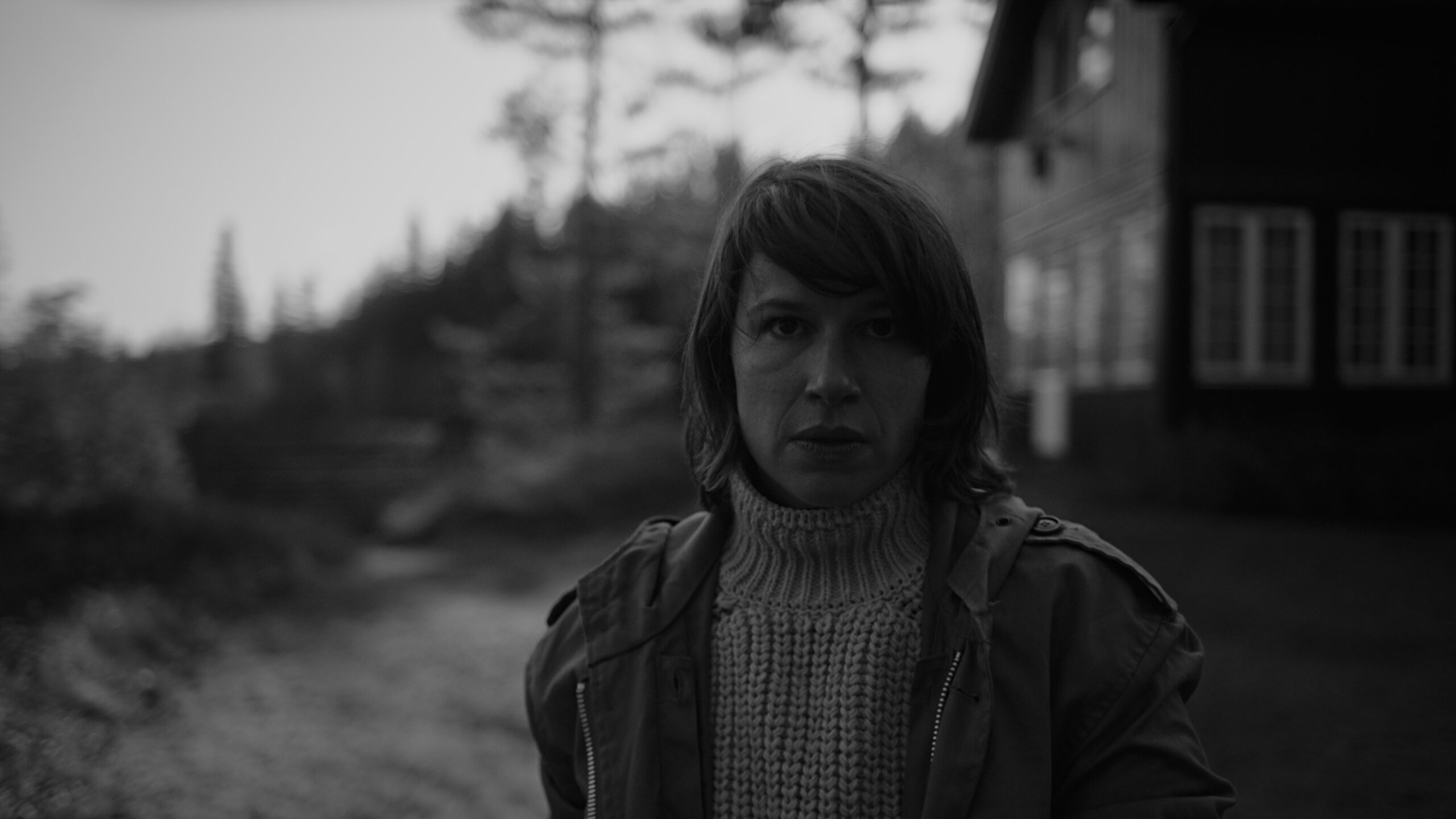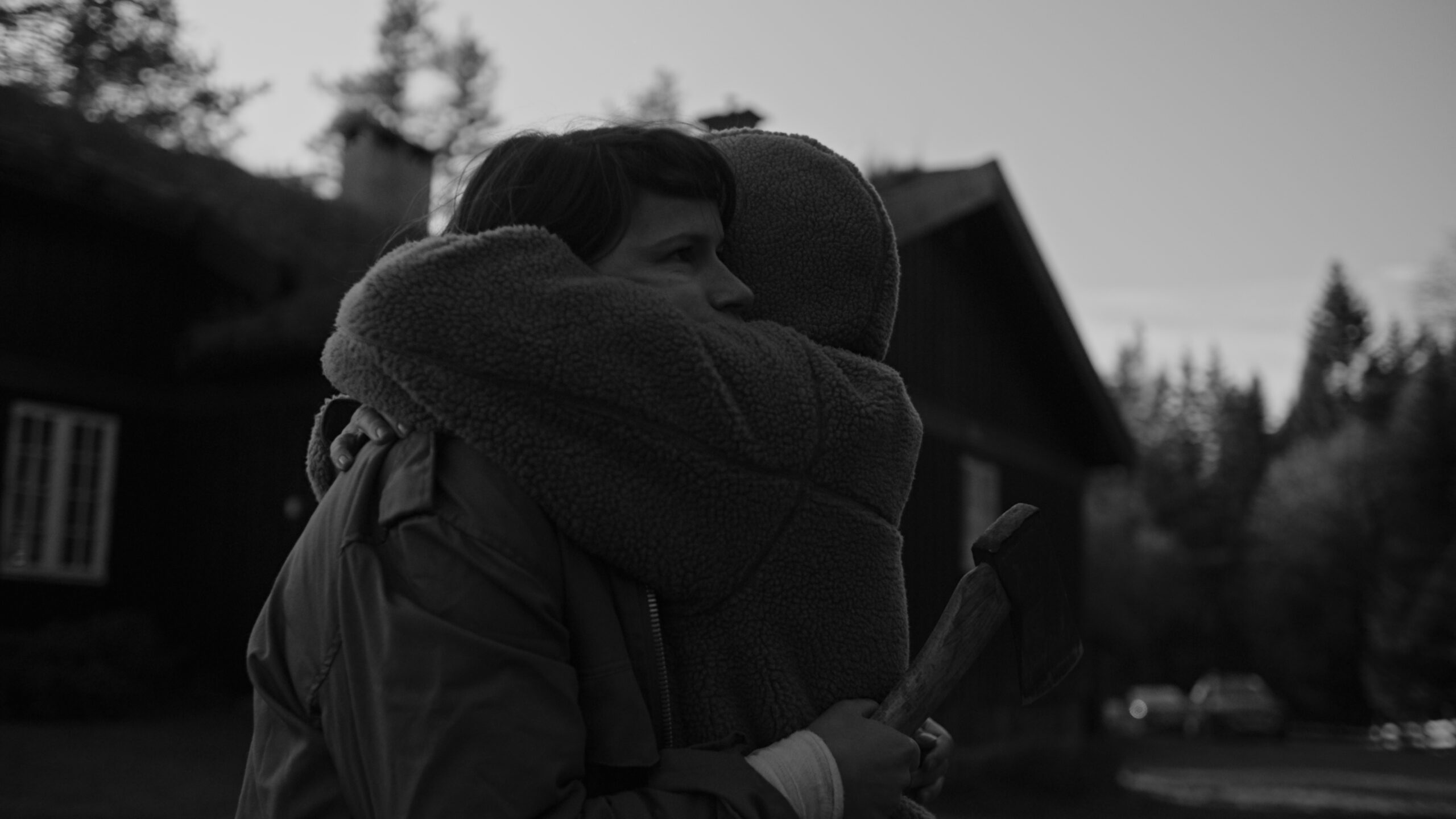Want to hear more from the actors and creators of your favorite shows and films? Subscribe to The Cinema Spot on YouTube for all of our upcoming interviews!
The second feature film that I have had the pleasure of watching at this year’s Fantastic Fest—and the first that I will be reviewing—is a psychological horror drama. Executive produced by Elijah Wood (A Girl Walks Home Alone at Night, Mandy, Daniel Isn’t Real, Rabbit Trap), Demring (or Dawning) calls upon astonishing filmmaking, with no cinematic elements weighing down the narrative, and hard-hitting storytelling as it approaches its harsh final act. In nearly an hour and forty-nine minutes, this Norwegian film boldly tackles different thought-provoking, mature concepts and themes, including loss, empathy, intuition, and collaborative strength.
Demring (or Dawning) is written and directed by producer Patrik Syversen.
In this review, I will discuss Demring (or Dawning). As this article’s title suggests, no spoilers will be present.
Trigger Warning: This film involves instances of depression, suicide, violence against women, and more.

Dawning/ Demring Synopsis
Here is the official synopsis for Patrik Syversen’s psychological horror-drama film, Demring (or Dawning).
Three sisters withdraw to their family’s vacation home to process a traumatic incident. When they in addition find out that their mother has passed, the two eldest sisters decide not to tell the youngest. As secrets and lies come to light, an unexpected visitor arrives.
Patrik Syversen
Discussion
I would hate to compare this film to other existing films—in the same manner that characters relate their reality to others—, but I see Dawning as an incredibly distant parallel to Aftersun and even Anatomy of a Fall in the treatment of its characters and in how American popular culture surprisingly finds its way into European household environments. Patrik Syversen’s direction is felt in every corner, angle, scene, and act, occupied masterfully by its lead actors. In its runtime, there is a myriad of noteworthy material to work with, as it even attempts to surpass a nonlinear narrative structure.
Shot primarily in black-and-white—until its midway point, where it introduces color scheming through flashbacks thanks to colorist Nicke Cantarelli—, Dawning is evidently meticulous about its identity as well as its aim to guide the audience where characters believe they will go. Syversen builds a world around a family mountain cabin, described as “a traditional, albeit slightly lavish, building”. The opening shot and those that follow exhibit admirable austere façets.
A Pristine Production
Cinematographer Andreas Johannessen is skillful with the camera, even directing an insightful moment between the sibling protagonists via drone. The camera captures incredible panning movements, one-take moments, and every now and then, both. The filmmaker and the actors get the execution down perfectly, captivating viewers with subtle action and conversation to carry the narrative forward. The first panning shot is telling imagery, with the middle sister, Cecilie Isaksen (Silje Storstein), strumming a guitar to display her artistic skill, while the youngest sister, Kristine Isaksen (Kathrine Thorborg Johansen), repeatedly drops an axe to make firewood. The most vital one-take scenes focus on each sister’s individual testimony of lived events. Next to that is my personal favorite—as the camera moves around a dining table oratory between the sisters and their partners at the transition into the final act.
I also appreciate the camera’s shifting of perspectives from Cecilie and the oldest sister, Esther Isaksen (Marte Magnusdotter Solem), in the first half of the film, to Kristine in the second half, e.g., Johannessen switching from Kristine in the foreground to Esther as they try to perform a good deed. Editors Erlend Mjømen Knudsen and Syversen offer a strong transitional cut here. In doing so, they help display the different character aspects of running into trouble on the road. Syversen’s direction of the tonal shift illustrates potency, with one sister rushing back home as the camera pulls away from the scene. Conversely, there is a mesmerizing shot of Kristine coming into view ahead of a blurry frame, as if her mind is reaching clarity.
Syversen’s Screenwriting
The development of the sisters raised to be “art brut[s]” as opposed to philistinians is interesting, given the sisters’ internal conflict to express themselves. Timing is a massive obstacle that they strive tremendously to overcome. The result of such timing will define a perception of Syversen as a storyteller through the medium of cinema. As the narrative progresses, the overall conflict becomes less about Esther and Cecilie’s struggle to inform Kristine of their personal loss. Instead, it becomes more about the outcome of whether this ever happens…and when. Esther argues, “Can’t we spare her [Kristine] the pain and gather our thoughts?”. It’s an ironic line for a psychological horror film wherein physical pain is bound to be experienced as they must think quickly on their feet.
Understandably, Kristine’s intuition is her greatest strength. It reaches a point where the filmmaker smartly juxtaposes intelligence and wisdom through the adult characters. Esther’s assertion that “traditions by their nature are repetitive” speaks of generational trauma, that danger and safety are inevitably inherited in life. There appears to be a critical lens into race and, to some extent, sex, as Syversen juxtaposes the cosmic horror of H.P. Lovecraft’s literary works with the science fiction of an African American literary figure and queer cinema. This window, too, contributes to the idea of intelligent humans in danger at the hands of the unwise.
The filmmaker wraps Dawning with a bit of virtual reality (VR) video gaming during the epilogue as the cherry atop the narrative. It looks at humans in one reality, peering into the reality of another, and making critical choices that don’t produce a lasting effect in sentient eyes.
Music and Mayhem
Music composer Øystein Greni’s soundtrack isn’t often present. Yet, whenever it is, the score beautifully complements the narrative. As the sisters leave home, the music showcases the nature of their environment, with establishing shots made of towering trees, the long and winding road, and the wider landscape that they pass through. “Für Elise” by Beethoven is incorporated as Kristine feels loneliness, whereas her two older sisters are both in love and in relationships with other people.
Greni composes an unsettling score to maintain a despairing tone as Syversen makes the first jump back into the present from the narrative’s first flashback. Moreover, there is an instance of a cosmic track to add a layer of possibility for the conflict. Sound designer Anders Mørk’s haunting noises of chains and a swinging axe afflict an immediate sense of looming apprehension. I believe these are nice choices with the themes that the filmmaker has in store for viewers.

The Crew Behind Dawning/ Demring
Producer Andreas Johannessen serves as the cinematographer.
Stian Fjeldstad serves as the drone operator.
Erlend Mjømen Knudsen and Syversen serve as the editors. Nicke Cantarelli is the colorist.
Øystein Greni serves as the music composer. Anders Mørk serves as the sound designer.
Kai Kolstad Rodseth serves as the stunt coordinator.
Hanne Iveland Henriksbø serves as the costume supervisor.
Michelle Johansson and Jim Udenberg serve as the special makeup effects artists.
The Cast of Dawning/ Demring
Kathrine Thorborg Johansen portrays the protagonist, Kristine Isaksen.
Silje Storstein plays Cecilie, the middle sister in the Isaksen family.
Marte Magnusdotter Solem portrays Esther, the oldest sister in the Isaksen family.
Sigurd Myhre portrays Even, Esther’s husband.
Steinar Klouman Hallert portrays Adrian, Cecilie’s romantic partner.
Thorbjørn Harr portrays Lukas, a mysterious man who lives a few miles away from the sisters’ family cabin.
Maude Syversen Irvoll and Noelle Irvoll DeYoung portray Lily and Inga, Esther and Even’s younger and older daughters, respectively.
Bendik Kaltenborn plays Kristine’s psychiatrist.
Hedda Virik (The Worst Person in the World, No Time to Die, Sentimental Value) portrays Kiaeresten.

Performances and Character Developments
Thorborg Johansen is easily the best performer in this film. Kristine’s depressed state is understandable and relatable, and as time progresses, her psyche gets the best of her. She oscillates between rationality and irrationality, clashing with Even’s certain point of view towards art, namely in catharsis in art reflecting life. I find her painting of anthropomorphic characters a subtle representation of animal instincts. The references to a dog that the sisters’ mother may or may not have had are a clever reference to inherited intuition. Thorborg Johansen demonstrates Kristine’s humanity through a visceral form of pain.
Magnusdotter Solem represents Esther’s optimism as “smiling through the pain” quite well. The character doesn’t realize she’s inherited her mother’s proclivity for structure and traditions, the belief that things must be done at a proper time and place. Simultaneously, she is a risk-taker, such as in her willingness to help others. That sort of personality trait can be a pharmakon, and it’s difficult when Esther’s judgment gets clouded. She fights for control as a result of growing up adventurous.
In the first half of the film, I love the dynamic established between Myhre’s Even and Magnusdotter Solem’s Esther as a married couple. This is especially true in an aside arguing that Kristine is self-absorbed and highly sensitive. That portion of the film also establishes the dynamic of Kristine and Even as in-laws to one another, such as in attempts to bond over red wine. However, Myhre turns in a great performance in the third act. There, Even fervently expresses his aversion to “everything spiritual”, shooting down ideas of psychology in connection with human beings’ alternatively lived experiences. He is an intelligent man. Through him and others, Syversen strikes an intriguing discourse about the minuscule existence within the void.
Final Thoughts on Dawning/ Demring
That’s where we’re at. We’re changing socks. There’s time.
Esther Isaksen (Marte Magnusdotter Solem)
The kairos within this film’s narrative reminds us that time is not a friendly metaphysics of life. It is something to control and to manipulate to one’s advantage when necessary. With proper care of time comes room for rumination. Oxford Dictionary defines “dawning” as “the beginning or first appearance of something”. Similarly, as an adjective, it means “beginning to grow light” and “coming into existence”, or “becoming evident to the mind”. Syversen effectively exposes the truth in his narrative but tips the scale, creatively throwing the audience off balance. Because of its twisted intricacies, Dawning is easily at the top of my favorite films of the year.
5/5 stars
Patrik Syversen’s Dawning/ Demring is now playing at Fantastic Fest!
For more drama and horror-related news and reviews, follow The Cinema Spot on Facebook, Twitter, and Instagram! Also, follow us on Letterboxd for further feature film, short film, and limited series reviews!
Managing editor & film and television critic with a Bachelor's of Arts in English Literature with a Writing Minor from the University of Guam. Currently in graduate school completing a Master's in English Literature.



